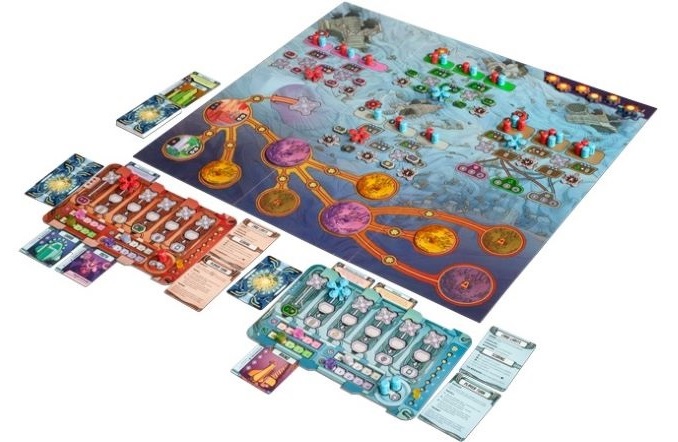Cryo Is an Elegant, Clever, and Pleasantly Morbid Worker-Placement Board Game
Games Reviews board games
Cryo is one of the more pleasantly morbid tabletop games I’ve played: Your ship has crash-landed on a forbiddingly cold planet, and you have to get your workers into the caverns below the surface before the sun sets or they’ll freeze to death. It’s a competitive game, even though you all arrived on the same cursed ship, and you’re constantly strapped for resources, but the game moves far quicker than the long setup might imply, and it strikes an ideal balance between long-range strategy and the short-term satisfaction of building an engine.
In Cryo, each player starts with 15 worker pods on the board, each located in stasis chambers in the four parts of the ship, and three drones on their own personal platforms. On each turn, you may move one drone from your platform to any open dock on the board, and then choose one of the two to four adjacent action spaces to execute—usually to gain one or two resources, or to use one or more resources to get something else, like energy or another card for your hand. (Tawantinsuyu had a similar mechanic, but it was far clumsier in practice, whereas Cryo makes it clean and simple.) You may also recall all your drones back to your platform at any time—and, if all your drones are out on the main board, you must take this action—during which you’ll resolve an Incident token that either gets you a resource or lets you sabotage an adjacent stasis chamber, destroying all pods within it (including your own!). When you recall drones, you can use an action on your platform below that drone’s landing spot, with the power to customize some of those actions or their costs over the course of the game.
The game has four main resources you can gather directly, but you can never have more than five units of any of them—and they go quickly once you get them, because most action spaces allow you to use them up to three times if you can pay the cost. There’s a fifth resource, energy, which you will almost exclusively have to get by creating it with other resources; without it, you can’t move your pods into the caverns, so a huge part of building your engine involves setting yourself up to gain energy.

The cards have four possible functions in the game, and you get limited chances to play them. One is as an upgrade, which sits under your platform, with just the top showing up, and gives you a significant additional power, like being able to land your drones on docks that are damaged, or letting you pay one energy to take a second action when you land a drone. The second is as a launch shuttle, the primary way to get pods into the caverns, which will sit below your platform until you send it on that one-way trip to oblivion. The third is as a game-end objective card, called a mission, which can add as much as 8-10 points if you execute it successfully. There’s only one natural space on the board that lets you play a card, as well as one space on your platform once you fill in the cost space, with just a few other scattered chances to do so. The fourth function of a card is available any time, once per turn, where you scrap the card for the two resources shown on the side of the card as its scrap value. There are only eight unique card types in the deck, so holding on to a specific card in the hopes that you’ll get to play it later is often not as smart a plan as using it for something else (including scrap) and trying to get more cards at some other point.
Even though there are a lot of moving parts in Cryo, the game flies. You place a drone, take one action, maybe repeating it up to three times; or you bring your drones back, gain some stuff, take an Incident token. And in most cases that’s your whole turn. You can and will plan ahead, and you’ll build a small engine by upgrading your platform, but your moves will never be long or complicated, and I’d say the potential for analysis paralysis in this game is on the small side. Despite the fact that you’ll always find yourself strapped for one resource or another, it doesn’t have the stress of being short of food in Agricola or emperor’s track points in Grand Austria Hotel. You just have to take an extra turn to go get the resource and move on.
Cryo comes from from the designers of The Manhattan Project: Energy Empire, a 2016 title that’s very highly rated but which I’ve never played; and from the Z-Man imprint, which has a well-deserved reputation for publishing some of the best mid- to heavyweight Eurogames, including Agricola, Le Havre, and the entire line of Pandemic games. The components here are very well-made and attractive, right down to the little resource cube markers and the drones you’ll place on the board, with a bright color scheme that contrasts (in a good way) with the funereal theme of the game. The listed game time of 60-90 minutes seems about right, if you include the setup, because the game is bounded by time—when the incident tokens all run out, you get to the sunset token, and once that’s claimed the game ends immediately. I can’t speak to how this compares to Energy Empire, but this is an elegant, clever, and quite fun mid-weight game, perfect if you like worker-placement or engine-building games but don’t want a heavy two-hour affair.
Keith Law is the author of The Inside Game and Smart Baseball and a senior baseball writer for The Athletic. You can find his personal blog the dish, covering games, literature, and more, at meadowparty.com/blog.